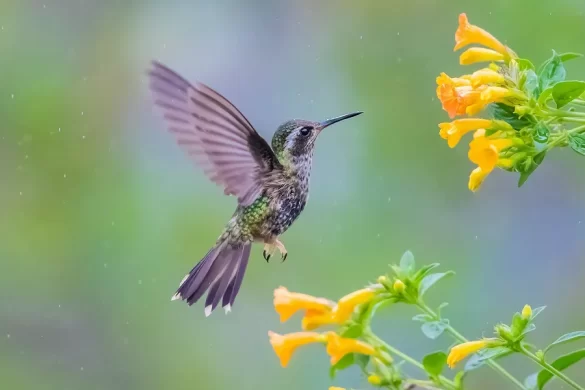Hummingbirds are some of the most fascinating and beautiful birds in the world. With their iridescent feathers, incredible aerial acrobatics, and unique abilities to hover in mid-air, they capture our imagination and inspire awe. But have you ever wondered if these tiny birds are color blind?
The short answer is no, hummingbirds are not color blind. However, their vision is different from that of humans, and they see colors differently than we do.
How Do Hummingbirds See Colors?
Hummingbirds have a wider range of color perception than humans. While humans can see three primary colors (red, blue, and green), hummingbirds can see ultraviolet light, which means they can see colors beyond what humans can see.
To understand this better, let’s look at how color vision works. The human eye has three types of cone cells that are responsible for color vision. Each type responds to different wavelengths of light: short, medium, and long. These cones work together to create the perception of color.
In contrast, hummingbirds have four types of cone cells in their eyes, including one that is sensitive to ultraviolet light. This gives them an expanded range of color vision and allows them to see colors that are outside of the human visible spectrum.
Do Hummingbirds Prefer Certain Colors?
While hummingbirds have a wider range of color perception than humans, they also have preferences when it comes to colors. In general, they are attracted to bright, bold colors such as red, orange, and pink. This is because these colors are often associated with food sources, such as nectar-rich flowers.
However, it’s important to note that not all hummingbirds are attracted to the same colors. Different species may have different preferences, depending on the availability of certain food sources in their habitat.
In addition, factors such as lighting and background color can also affect a hummingbird’s perception of color. For example, a flower that appears bright and attractive to a hummingbird in direct sunlight may appear dull and unappealing in shade.
How Do Hummingbirds Use Their Color Vision?
Hummingbirds use their color vision for a variety of purposes, including finding food, attracting mates, and navigating their environment.
When it comes to finding food, hummingbirds rely on their ability to see colors to locate nectar-rich flowers. They are particularly attracted to brightly colored flowers that contain high amounts of nectar.
In addition, male hummingbirds use their colorful feathers to attract mates. Many species of male hummingbirds have bright, iridescent feathers that reflect light in different ways, creating a stunning visual display. Female hummingbirds use their color vision to evaluate the quality of these displays and choose the most attractive mate.
Finally, hummingbirds also use their color vision to navigate their environment. They are able to distinguish between different shades of green, which helps them navigate through foliage and locate potential food sources.
Conclusion
So, are hummingbirds color blind? No, they are not. While their vision is different from that of humans, hummingbirds have an expanded range of color perception that allows them to see colors beyond what we can see. This enables them to find food, attract mates, and navigate their environment more effectively.
Understanding how hummingbirds see colors can help us appreciate these amazing birds even more and develop strategies to protect their habitats and food sources. So the next time you see a hummingbird, take a moment to admire its brilliant colors and unique abilities.


 Facebook
Facebook  Instagram
Instagram  Youtube
Youtube 